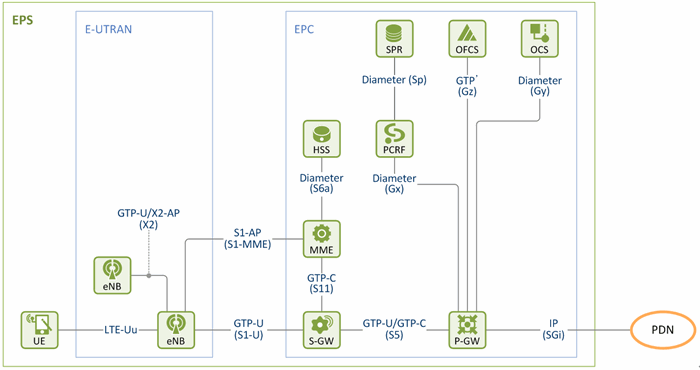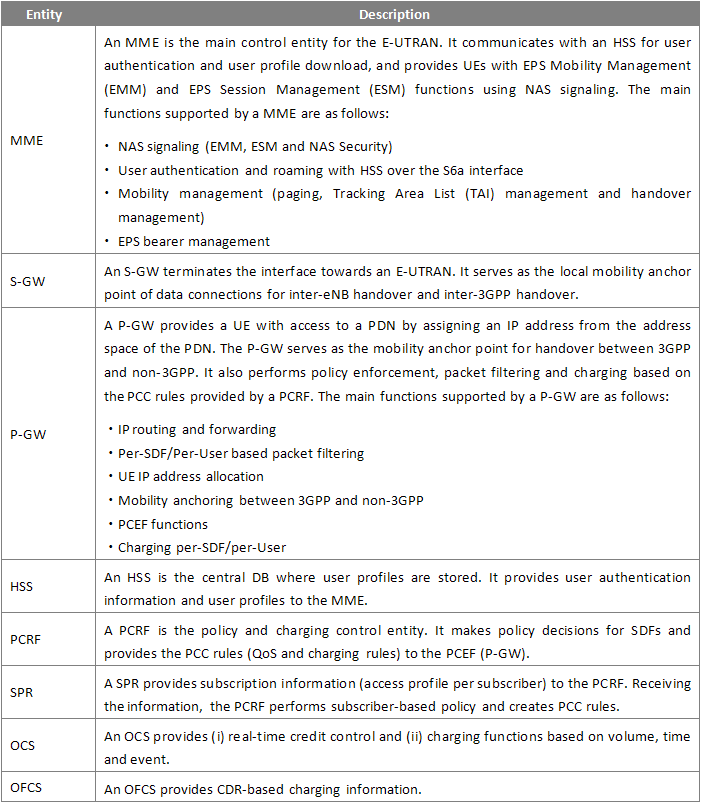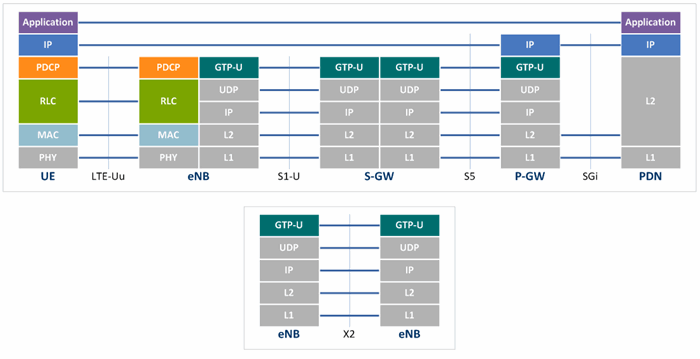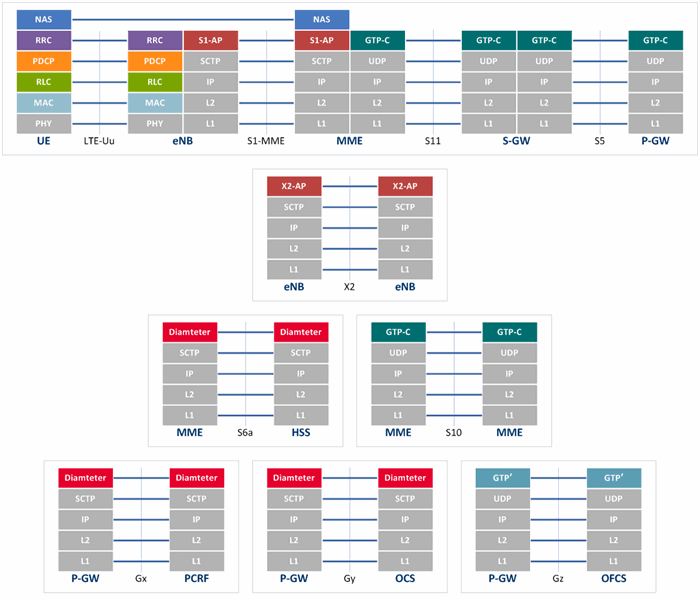1. Introduction
This document presents the LTE network architecture as the first technical document of “LTE” area. The LTE network called EPS (Evolved Packet System) is an end-to-end (E2E) all IP network; EPS is divided into two parts - LTE part which deals with the technology related to a radio access network (E-UTRAN) and EPC part which deals with the technology related to a core network. An E2E all IP network means that all traffic flows – from a UE all the way to a PDN which connects to a service entity – are transferred based on IP protocol within EPS.
In order for LTE services to be provided to a user over the LTE network, an E2E LTE network reference model (NRM) is generally comprised of three additional domains - BSS/OSS domain for subscriber, application domain for providing services, and IP transport network domain for sending IP packets – in addition to basic EPS domain. The scope of this document is focused on the basic EPS domain. Other EPS domain features, such as the architectures for LTE interworking with 3GPP/non-3GPP and roaming, are out of the scope of this document and will be described in other technical documents later.
The remainder of this document is organized as follows. In Chapter 2, the LTE network reference model is defined and the EPS entities and interfaces are explained. Chapter 3 will describe the protocol stacks and then Chapter 4 will explain traffic flows over the LTE network.
2. LTE Network Reference Model
Figure 1 shows an LTE network reference model, consisting of LTE entities (UE and eNB) and EPC entities (S-GW, P-GW, MME, HSS, PCRF, SPR, OCS and OFCS). A PDN is an internal or external IP domain of the operator that a UE wants to communicate with, and provides the UE with services such as the Internet or IP Multimedia Subsystem (IMS). In the following, Table 1 and Table 2 show the functions of the LTE and EPC entities. Table 3 lists the reference points of the LTE network reference model and gives a description of interfaces between EPS entities.

Figure 1. LTE network reference model
Table 1. LTE entities

Table 2. EPC entities

Table 3. LTE interfaces

3. LTE Protocol Stacks
Based on the EPS entities and interfaces defined in Chapter II, the LTE protocol stacks for the user plane and control plane are described in Chapter III.
3.1 User plane protocol stacks
Figure 2 shows the user plane protocol stacks for the LTE network reference model shown in Figure 1. The functions of the key layers of the protocol stacks are briefly described below.

Figure 2. LTE user plane protocol stacks
1) LTE-Uu interface
- PDCP: The PDCP protocol supports efficient transport of IP packets over the radio link. It performs header compression, Access Stratum (AS) security (ciphering and integrity protection) and packet re-ordering/retransmission during handover.
- RLC: In the transmitting side, the RLC protocol constructs RLC PDU and provides the RLC PDU to the MAC layer. The RLC protocol performs segmentation/concatenation of PDCP PDUs during construction of the RLC PDU. In the receiving side, the RLC protocol performs reassembly of the RLC PDU to reconstruct the PDCP PDU. The RLC protocol has three operational modes (i.e. transparent mode, acknowledged mode and unacknowledged mode), and each offers different reliability levels. It also performs packet (the RLC PDU) re-ordering and retransmission.
- MAC: The MAC layer lies between the RLC layer and PHY layer. It is connected to the RLC layer through logical channels, and to the PHY layer through transport channels. Therefore, the MAC protocol supports multiplexing and de-multiplexing between logical channels and transport channels. Higher layers use different logical channels for different QoS metrics. The MAC protocol supports QoS by scheduling and prioritizing data from logical channels. The eNB scheduler makes sure radio resources are dynamically allocated to UEs and performs QoS control to ensure each bearer is allocated the negotiated QoS.
2) S1-U/S5/X2 interface
- GTP-U: GTP-U protocol1 is used to forward user IP packets over S1-U, S5 and X2 interfaces. When a GTP tunnel is established for data forwarding during LTE handover, an End Marker packet is transferred as the last packet over the GTP tunnel.
3.2 Control plane protocol stacks
Figure 3 shows the control plane protocol stacks for the LTE network reference model. The functions of the key layers of the protocol stacks are briefly described below.

Figure 3. LTE control plane protocol stacks
1) LTE-Uu Interface
- NAS2: NAS protocol performs mobility management and bearer management functions.
- RRC: RRC protocol supports the transfer of the NAS signaling. It also performs functions required for efficient management of the radio resources. The main functions are as follows:
- Broadcasting of system information
- Setup, reconfiguration, reestablishment and release of the RRC connection
- Setup, modification and release of the radio bearer
- Same as in user plane
- Same as in user plane
- Same as in user plane
2) X2 interface
- X2AP: X2AP protocol supports UE mobility and SON functions within the E-UTRAN. To support UE mobility, the X2AP protocol provides functions such as user data forwarding, transfer of SN status and UE context release. For SON functions, eNBs exchange resource status information, traffic load information and eNB configuration update information, and coordinate each other to adjust mobility parameters using the X2AP protocol.
3) S1-MME interface
- S1AP: S1AP protocol supports functions such as S1 interface management, E-RAB management, NAS signaling transport and UE context management. It delivers the initial UE context to the eNB to setup E-RAB(s) and manages modification or release of the UE context thereafter.
4) S11/S5/S10 interfaces
- GTP-C: GTP-C protocol supports exchange of control information for creation, modification and termination for GTP tunnels. It creates data forwarding tunnels in case of LTE handover.
5) S6a interface
- Diameter: Diameter protocol supports exchange of subscription and subscriber authentication information between the HSS and MME.
6) Gx interface
- Diameter: Diameter protocol supports delivery of PCC rules from the PCRF to the PCEF (P-GW).
7) Gy interface
- Diameter: Diameter protocol supports exchange of real-time credit control information between the P-GW and OCS.
8) Gz interface
- GTP’: GTP’ protocol supports CDR transfer from the P-GW to the OFCS.
You guys made LTE learning Easy for freshers also. Please Upload some Technical Documents related to PCRF call flows in Detail. because i am working on PCRF project.
Thank you.
Thank you..
On S11 interface, does it provide GTP tunnel per bearer?? I think it should be GTP tunnel per user on S11 Interface.
Hi Rakesh,
Thank you for noticing the error.
We have fixed it and posted the updated file.
Thank you again for your kine comment and sorry for the late reply.
Good One.
Hi,
Could you please provide LTE roaming call establishing e2e doccuments.
Thanks for sharing valuable doccuments on LTE.
email id: singh.jp111@gmail.com
Hi
In LTE network how many MME is needed? or How many user one MME can support?
Netmanias LTE series would be best of the best to understand LTE network. Thank you alot!
hi, I think that: there are two way for offline charging is OFCS and CG. They use interface Gz (incluce Ga and Rf). If it is OFCS, the interface is Rf and uses Diameter protocol. If it is CG, the interface is Ga and uses GTP' protocol. Please check again!
In Above Diagram it shows Interface b/w OFCS and P-GW is Gz which will use GTP Protocol .. but Gz is actually uses diameter protocol isn't it ?? got confused can u pls explain it clearly
Hi, Nguyen & Rajeswari,
As far as I know OFCS can have both Gz (GTP') and Rf (Diameter) interfaces as shown figure below.
If my understading is correct, the Netmanias document (figure 3 above) is not wrong.
Hello everyone!
I don't understand this paragraph
"When a GTP tunnel is established on the S1-U interface, the S-GW assigns a TEID (UL S1-TEID in Figure 4(a)) for uplink traffic and the eNB assigns a TEID (DL S1-TEID in Figure 4(b)) for downlink traffic."
The eNB encapsulates the user IP packets with the S1 GTP tunnel header and forwards the resulting outer IP packets to the S-GW.
So why S-GW assigns TEID for uplink traffic? Why not eNB assigns??
The S-GW, based on the value "UL S1-TEID" in the received packet from the eNB, figures out to which P-GW and with what "UL S5-TEID" to send the packet. If eNB assings "UL S1-TEID", there's no way to know mapping between "UL S1-TEID" and "UL S5-TEID" in S-GW.
That is, packet receving node should assigns TEID as shown below:
- UL S1-TEID is assinged by S-GW during attach procedure, then eNB uses UL S1-TEID when it sends packet to S-GW
- UL S5-TEID is assinged by P-GW during attach procedure, then S-GW uses UL S5-TEID when it sends packet to P-GW
- DL S5-TEID is assinged by S-GW during attach procedure, then P-GW uses DL S5-TEID when it sends packet to S-GW
- DL S1-TEID is assinged by eNB during attach procedure, then S-GW uses DL S1-TEID when it sends packet to eNB
For more information you can refer to the link below:
https://www.netmanias.com/en/?m=view&id=blog&no=5928
good, thanks
Hi John Lee
Thank you very much!
Hi,
This is srilakshmi.
could you please share a document on LTE roaming and how does charing works for roaming in lte.
This introduction was well done. Please help us with more insight with topic like DRX, Power, scheduling and others more.
Hi,
Thanks for sharing the Info on LTE,,its worth usefull.Thanks a Lot.
Hari
HI,
thanks for the info..
can we download the pdf files for the same.
The follwoing queries are on UE side.
1) What is the mechanism used at UE to select the PDCP Entity for UL IP pakcets?
2) Is DHCP used to get the assined at UE with DHCP server running on PGW and client on UE?
According to the 3GPP standards, UE can get IP address using DHCP protocol, but it is not common in real network. Usually UE will get IP address from P-GW during LTE attach procedure (with no DHCP procedure). You can find IP address allocation document at https://www.netmanias.com/en/?m=view&id=techdocs&no=7246
Thanks for providing information on query #2. It was really helpful
Any information on #1?
Good One
Very Good Article. Thank you for sharing
IS IT REQUIRED TO HAVE PCRF FOR A CAPATIVE NETWORK LIKE INTRA RAILWAYS NETWORK?
Thank you for this very informative & detailed article Netmanias.
Team Celitech.
Why there is no BMC layer in LTE?
Hi Netmanias
how much TEID will be, if more than 2 UE attach on LTE, is it equal to number of UE supported, or just only one, and using together all UEs